Acerola Cherry: Origins - Consumption - Nutrition Facts - Health Benefits
|
|
|
Contents
- Geographic origin and regions grown
- Common consumption of Acerola Cherry today
- Nutrition Facts: Vitamins, minerals and phytochemical components
- Health Benefits: Medicinal uses based on scientific studies
- Bibliography
Geographic Origins and Regions Grown
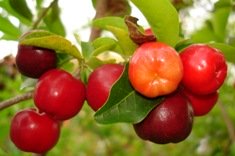 |
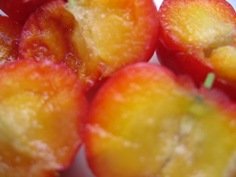 |
You don’t have go as far as India to track down some acerola cherries, just look for them during your next trip to the Caribbean. They are native to the Caribbean and northern parts of South America and are also cultivated in India.
This is a tropical shrub or miniature tree resembling the true cherry, although they are unrelated. The common names for the fruit include Barbados cherry and wild crapemyrtle though these are probably not all of the common names.
Common Consumption Today
Although the acerola is not the true cherry, it is a cherry, and as in most parts of the world where it is grown, it is used similarly to real cherries. If you’re not flavoring your ice cream with it or topping some other tasty dessert like pudding or cake, chances are you will find it being used as a flavor for drinks, cocktails, and other desserts.
When preparing them for those purposes, just cook the cherries down to a soft mixture that you can strain to remove the seeds easily. The resulting sauce can enhance any delicacy. For those willing to wait a little longer to enjoy these cherries they make a great jam or jelly.
However, don’t forget about the acid content of these cherries. If you eat too many of them you will know exactly what I am talking about. The ascorbic acid does serve a purpose though. If you try some of these and they are extremely tart, the acidity indicates that there is a very high vitamin C content.
When used in fruit salads it is one of those things that keep bananas and apples from changing color, the same way lime or lemon juice does. We all know that nobody likes a brown fruit salad. Plus it gives some zing to fruit punch.
If you have purchased a juice product, with acerola cherry juice being no exception, it can lose its flavor and vitamin C within a month. To maintain the quality of the juice, it is best to store unopened cans in the refrigerator.
In addition, one should take care when storing this fruit in their raw, fresh state. They bruise easily and can deteriorate rapidly because of these bruises. They should be used within three to five days after picking for an optimal taste and to ensure consumption of the highest vitamin C levels.
Nutrition Facts: Vitamins, Minerals and Phytochemical Components
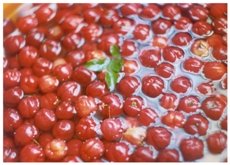 |
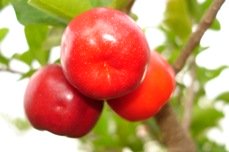 |
These cherries are often very juicy, usually have both a sweet and sour flavor, and are very high in nutrients including vitamin C. It is astonishing that one tiny acerola cherry has more vitamin C than an orange.
Here’s the detail:
65 times more vitamin C content can be found in one cherry than that of an orange, equaling the recommended minimum daily requirement for one person. It is used in many commercial vitamins and nutritional products mainly because of this vitamin C content which is preferable to a synthetic version.
It is the second richest fruit source of vitamin C, topped only by camu-camu.
Also, acerola cherries contain about double the vitamin B5, magnesium, and potassium of oranges. They have high levels of vitamin A, equal to that of raw carrots.
The vitamin B1, vitamin B2, and vitamin B3 concentrations are very similar to other fruits. Acerola cherries are also the proud carriers of key minerals such as calcium, iron, and phosphorus beyond their A, B, and C vitamin content.
Aside from these essential and important minerals, they also contain other antioxidants such as flavonoids and anthocyanins, part of the larger class of antioxidants, polyphenols.
A novel flavonoid has also been discovered in them (3), even though this fact does not rule out the possibility that this flavonoid may be present but undiscovered in other fruits.
Health Benefits: Medicinal Uses Based on Scientific Studies
Acerola is often considered a beneficial fruit for patients with liver disorders, diarrhea and dysentery (7). Patients with the common coughs and colds also benefit from this wonderful fruit.
The juice may be gargled to relieve a sore throat. Acerola is also known to strengthen the immune system (5), (6), (7) because of the high vitamin C content, which in turn prevents heart disease and protects against cancer (1), (4).
In spite of the fact that few medical studies have been publish about acerola cherries, including in vitro and animal studies, the current results look quite promising. One study showed that, for example, acerola cherries may enhance soy and alfalfa’s ability to lower high cholesterol (2).
A second study demonstrated antifungal properties of the fruit. Acerola is currently being used in cosmetics because the nutrients it contains, including vitamin C, have come to the scientific community’s attention as an anti-aging skin treatment potential process.
Polyphenols from acerola have also shown reductions in the blood glucose levels of mice, which may prove to be a useful anti-diabetic treatment.
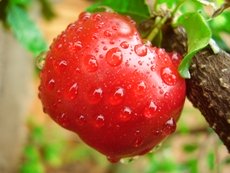 |
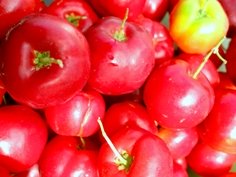 |
Bibliography
- Faloon, W. (2006). FDA threatens to raid cherry orchards. Life Extension Magazine, March 2006. Retrieved November 3, 2007 from http://www.lef.org/magazine/mag2006/mar2006_awsi_01.htm.
- Hwang J, Hodis HN, Sevanian A. (2001). Soy and alfalfa phytoestrogen extracts become potent low-density lipoprotein antioxidants in the presence of acerola cherry extract. Journal of Agricultural and Food Chemistry, 49(1):308-14.
- Kawaguchi M, Tanabe H, Nagamine K. (2007). Isolation and characterization of a novel flavonoid possessing a 4,2''-glycosidic linkage from green mature acerola (Malpighia emarginata DC.) fruit. Bioscience, Biotechnology and Biochemistry, 71(5):1130-5.
- Kiefer, I., Prock, P., Lawrence, C., Wise, J., Bieger, W. Bayer, P., et al. (2004). Supplementation with mixed fruit and vegetable juice concentrates increased serum antioxidants and folate in healthy adults. Journal of the American College of Nutrition, 23(3), 205-211.
- Nantz, M. P., Rowe, C. A., Nieves, Jr., C., & Percival, S. S. (2006). Immunity and antioxidant capacity in humans is enhanced by consumption of a dried, encapsulated fruit and vegetable juice concentrate. Journal of Nutrition, 136, 2606-2610
- Simopoulos, A. P., Gopalan, C. (eds). (2003). Plants in human health and nutrition policy. World Review of Nutrition and Dietetics, 91, 67-75.
- Xu, B. J., Yuan, S. H., & Chang, S. K. C. (2007). Comparative studies on the antioxidant activities of nine common food legumes against copper-induced human low-density lipoprotein oxidation: In vitro. Journal of Food Science, 72(7), S522–S527.
Disclaimer
Nutritiousfruit.com provides this website as a service. Although the information contained within the website is periodically updated, no guarantee is given that the information provided is correct, complete, and/or up-to-date. The materials contained on this website are provided for general information purposes only and do not constitute legal or other professional advice on any subject matter. Nutrtiousfruit.com does not accept any responsibility for any loss, which may arise from reliance on information contained on this website. The information and references in this website are intended solely for the general information for the reader. The content of this website are not intended to offer personal medical advice, diagnose health problems or to be used for treatment purposes. It is not a substitute for medical care provided by a licensed and qualified health professional. Please consult your health care provider for any advice on medications.
Didn't find what you were looking for? Search here...

Amazon Search Box:
Did you like this page?
|
|
|




